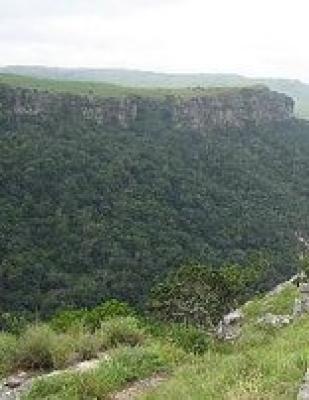There are various trails in this reserve to choose from, namely the Lourie Trail, a 2 km/1 hour trail, circular, the Ingungumbane Trail, a 4 km/ 3 hour circular trail, the Impunzi Trail, a 8 km/4 hour open-ended trail, the Fish Eagle Trail, a 8 km/4 hour circular trail, and the Nkonka Trail, a 8 km/6 hour open-ended trail. Shorter 500-m walks are also possible.
Bookings a few days in advance are required if you wish to be accompanied by a game guard. A map and information about the reserve are available at the entrance gates. Toilet and a bona with braai facilities available at the northern entrance gate: access to herbarium on request; parking areas at entrance gates; research hut available on request; contact The Officer in Charge.
The main attractions in the reserve includes a steep-sided forested gorge, botanically rich with many endemic species, plentiful, clear streams, far reaching, spacious views and magnificent sandstone koppies.
At present, the reserve is only available for day use. No fishing is permitted. The river is difficult to cross in rains and hikers should be wary of bilharzia. Summers are very hot: winters are generally quite mild in this area.
Groups of approximately 20 people can walk the trails, and an educational concession for school groups is available. For an extra fee, you can arrange for a game guard to accompany you.
On the northern banks of the Umtamvuna River and its magnificent gorge, which form the border between Transkei and Kwazulu/Natal, lies a developing and relatively unknown reserve, a paradise for day hikes.
The 3 257 ha Umtamvuna Nature Reserve is located on the road to Izingolweni, off the R61 to Port Edward, and is the best example of the eastern coastal sandstone region in South Africa, and the only example of Pondoland coastal highland sour veld under coastal management. The fortress-like koppies and sandstone cliffs, grasslands scattered with wild flowers and dense riverine rain forest with numerous pretty waterfalls tumbling into the gorge have a magical quality.
Over 250 bird species, including Gurney's sugar birds, crowned eagles, peregrine falcons, and breeding colonies of Cape vultures and fish eagles, plus more than 100 species of identified plants, contribute to the biological richness of the area.
Some of the protected rarer plants include the wild rubber fig, Fichus polita (bizane), the iron- wood Olea capensis subsp. 'evervis', the Natal cycad, Encephalartos natalensis, Syzygium cordatum, waterberry; the Natal flame bush, Alberta magna; and Manilkara nicholsonii.
If lucky, hikers can also observe baboons, the southern or common reedbuck, blesbok, bushbuck, blue and grey duiker, serval and caracal and many other small mammals.
The Lourie and Fish Eagle trails start and end at the southern entrance to the reserve, while the other three trails are located in the northern section of the reserve.
A reasonable level of fitness is required for the more strenuous Fish Eagle, Nkonka and Ingungumbane trails as these routes involve climbing up and down the steep rocky cliffs that border the Umtamvuna River.
Enthusiastic hikers can plan a longer walk by combining two routes, for example, the outgoing half of the Fish Eagle Trail can be combined with the Impunzi trail for a 12 km/6 hour-route that takes you across the reserve.
